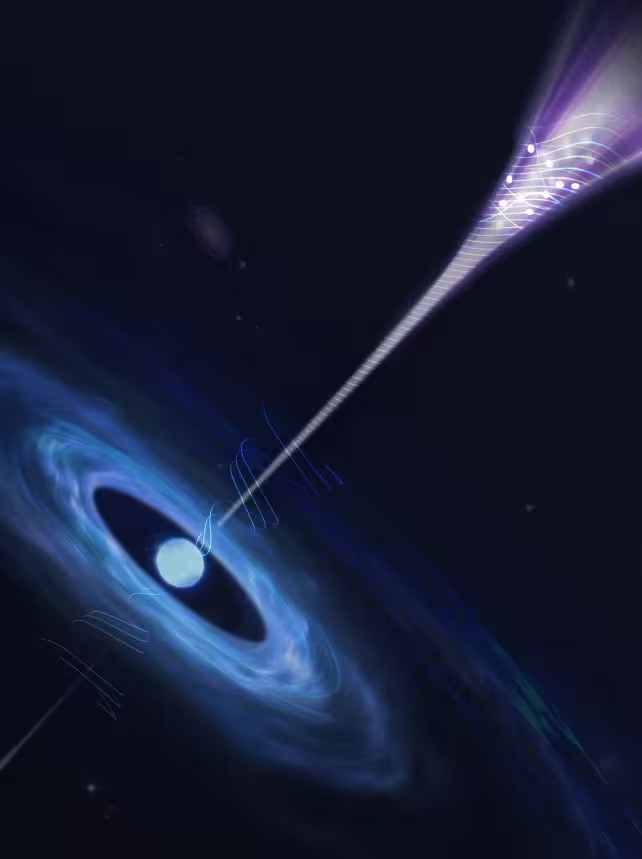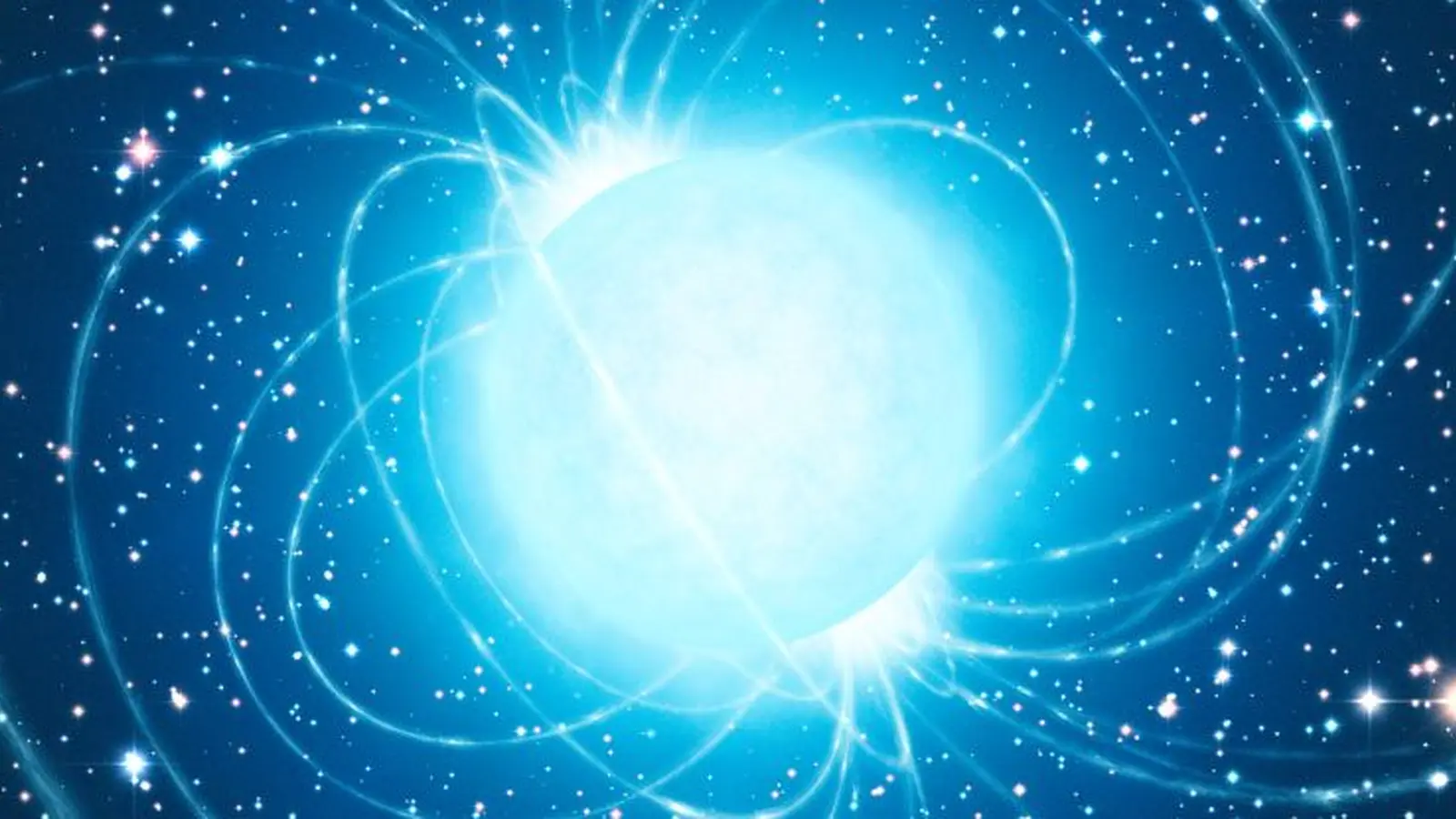6 Minutes
Discovery: a heartbeat hidden in a gamma-ray burst
An international team of astronomers has identified a fleeting, periodic gamma-ray oscillation inside a powerful space explosion whose light reached Earth in 2023. The event, GRB 230307A, was extraordinary: a long-duration gamma-ray burst (GRB) that lasted around 200 seconds and was one of the brightest bursts recorded. Detailed analysis led by Run-Chao Chen of Nanjing University now suggests the brief periodic signal could be the first detectable rotation-powered signature from a nascent magnetar — a rapidly spinning, highly magnetized neutron star.
Scientific background: gamma-ray bursts, kilonovae and magnetars
Gamma-ray bursts are the Universe's most energetic electromagnetic explosions. Traditionally, two primary progenitors are recognized: short GRBs (less than two seconds), typically tied to neutron star mergers and kilonovae, and long GRBs (longer than two seconds), associated with the core collapse of massive stars and the birth of black holes. Yet a minority of long bursts defy this dichotomy. GRB 230307A and an earlier anomalous event, GRB 211211A (2021), showed long durations yet displayed afterglow and spectral features resembling kilonovae—transient optical/infrared emission produced by heavy-element synthesis in neutron-star mergers.
When two neutron stars collide and merge, the remnant can be either a black hole or a more massive neutron star. The maximum stable neutron star mass is estimated to be around 2.3 solar masses; if the merged mass stays below that threshold, the remnant may survive briefly or long-term as a hypermassive neutron star. In some cases this transient object can be a magnetar: a neutron star with magnetic fields orders of magnitude stronger than typical pulsars and spin periods of milliseconds. Magnetars are candidate central engines that can inject energy into the ejecta and the GRB jet, altering light curves and emission spectra.
Observations and data analysis
GRB 230307A was detected on 7 March 2023. Its overall duration and brightness initially placed it among long GRBs, yet follow-up photometry and spectroscopy pointed to a kilonova-like aftermath, hinting at a neutron-star merger origin. Chen and colleagues re-examined high-time-resolution gamma-ray data from the burst. They report a weak but statistically significant periodic modulation lasting just 160 milliseconds and appearing 24.4 seconds after the initial trigger.

An artist's impression of the magnetar's signal in GRB 230307A. (Yuja Tian and Yuting Wu, Nanjing Zhijiao Cloud Intelligent Technology Co., Ltd.)
The periodicity matches expectations for a millisecond magnetar: a rapidly rotating object whose spin is imprinted on the outflow through strong magnetic fields. Physicist Bing Zhang of the University of Hong Kong, a co-author on the study, explained the interpretation: the newborn magnetar’s rapid rotation and intense magnetization can induce asymmetries in the relativistic jet, briefly modulating the observed gamma-ray flux. Because GRB jets evolve quickly and often become symmetric, the periodic imprint may only be visible for a short interval — consistent with the 160 ms window recorded in GRB 230307A.
Key discoveries and implications
If confirmed, this detection would represent the first direct measurement of a periodic signal attributable to a millisecond magnetar embedded within a GRB jet. The result strengthens the case that some neutron-star mergers produce long-lived, highly magnetized remnants rather than collapsing immediately into black holes. That conclusion has significant implications:
- It expands our understanding of central engines powering some GRBs and kilonovae.
- It provides an observational pathway to probe magnetar birth physics and magnetic-field amplification during mergers.
- It links electromagnetic signatures to potential gravitational-wave counterparts, reinforcing multimessenger strategies.
The evidence also suggests that magnetic processes, rather than purely baryonic outflows, dominated the jet launching in this instance. A magnetically driven jet can carry coherent structures tied to the central object's spin, enabling short-lived periodic features to appear in gamma-ray light curves.
Related events and context
GRB 211211A, detected in 2021, is another long-duration burst associated with kilonova emission. Together, these events suggest there may be a subset of long GRBs that originate from compact-object mergers and that can produce magnetar remnants. Systematic searches for millisecond-scale periodicities in archived and future GRB datasets could reveal additional examples and refine statistics on how often mergers yield surviving magnetars.
Future prospects and technology
Detecting millisecond periodic signals in GRBs requires instruments with high temporal resolution and sensitivity in the gamma-ray band. Continued operation and coordination of space-based gamma-ray observatories, rapid optical/infrared follow-up for kilonova identification, and gravitational-wave detectors working in concert will improve identification rates. Planned missions with improved timing capabilities could increase the detection volume for such faint periodic imprints, enabling population studies of newborn magnetars.
Expert Insight
"Finding a short-lived periodic signature inside a complex gamma-ray burst is like spotting a lighthouse flicker through a storm," says Dr. Aisha Malik, an astrophysicist who studies compact-object mergers. "If this result holds up with independent analyses, it gives us a direct probe of the rotation and magnetic structure of a newborn magnetar — information that is otherwise extremely difficult to obtain. This will help constrain models for magnetic-field amplification in merger remnants and the link between GRBs and kilonovae."
Conclusion
The reported 160-ms periodic signal in GRB 230307A offers a compelling hint that magnetars can form in the aftermath of neutron-star mergers and briefly steer the gamma-ray jet with their rapid spin and extreme magnetic fields. Confirming and expanding such detections will deepen our understanding of compact-star physics, jet formation, and the diversity of GRB progenitors. Ongoing multimessenger observations and targeted searches in archival data are the next steps to establish how common magnetar births are in merger-driven transients.
Source: sciencealert


Leave a Comment